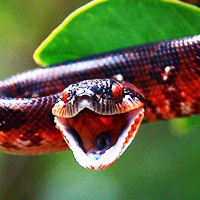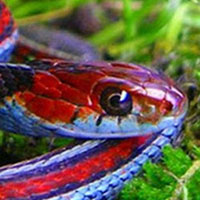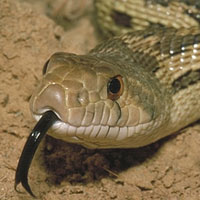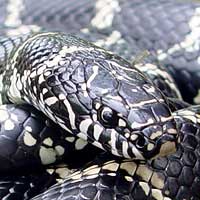Everything You Should Know About the Egyptian Sand Boa
The Egyptian Sand Boa is scientifically named Eryx colubrinus. It belongs to the Boidae family, which includes non-venomous constrictor snakes.
Scientific Name: Eryx colubrinus
Snake Family: Boidae
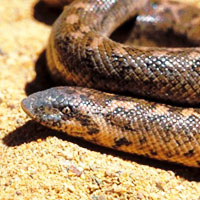
Egyptian Sand Boa: An Overview
The Egyptian Sand Boa (Eryx colubrinus) is a fascinating and adaptable snake species native to Northern Africa. Known for its small size, burrowing behavior, and unique coloration, this non-venomous boa has become a popular pet for reptile enthusiasts. Its manageable size and ease of care make it an excellent choice for both beginners and experienced keepers. In this guide, we’ll explore its habitat, diet, behavior, health, reproduction, and care needs.
Exploring the Natural Habitat of the Egyptian Sand Boa
The Egyptian Sand Boa is native to arid and semi-arid regions of Northern Africa, including Egypt, Sudan, and surrounding areas. These snakes are highly adapted to living in sandy and rocky terrains, where they spend much of their time burrowing.
| Habitat Feature | Description |
|---|---|
| Geography | North Africa: Egypt, Sudan, Libya |
| Preferred Terrain | Sandy deserts and scrublands |
| Climate | Hot days, cool nights, low humidity |
What Does the Egyptian Sand Boa Eat?
The Egyptian Sand Boa is a carnivore, feeding primarily on small mammals, birds, and reptiles in the wild. In captivity, its diet is straightforward and easy to manage.
- Juvenile Sand Boas: Feed on pinky mice every 5-7 days.
- Adult Sand Boas: Feed on appropriately sized rodents every 10-14 days.
- Feeding Tips: Always provide prey that is no larger than the snake’s girth.
- Hydration: Fresh water should always be available for drinking.
Behavior and Temperament of the Egyptian Sand Boa
The Egyptian Sand Boa is known for its docile and calm demeanor, making it a favorite among snake keepers. Its burrowing nature adds to its charm, as it spends much of its time hidden under the substrate.
- Burrowing Behavior: Prefers staying under sand or loose soil.
- Calm Temperament: Rarely aggressive and tolerates handling well.
- Activity Level: Primarily nocturnal, but may be seen basking in captivity.
Health and Lifespan of the Egyptian Sand Boa
With proper care, the Egyptian Sand Boa can live for 15-20 years in captivity. Monitoring their health and maintaining a clean, well-regulated environment are crucial for their longevity.
| Health Issue | Symptoms | Prevention |
|---|---|---|
| Respiratory Infection | Open-mouth breathing, wheezing | Maintain proper humidity and temperature |
| Mites | Itching, visible mites | Regularly clean the enclosure |
| Obesity | Excessive weight gain | Avoid overfeeding |
Reproduction in Egyptian Sand Boas
The Egyptian Sand Boa is ovoviviparous, meaning it gives birth to live young. This reproductive method is intriguing and a rewarding experience for breeders.
- Mating Season: Late winter to early spring.
- Gestation Period: 4-6 months.
- Litter Size: 6-12 live young on average.
- Provide adequate hiding spots and a controlled environment to encourage successful breeding.
Handling and Care Tips for the Egyptian Sand Boa
Handling and caring for an Egyptian Sand Boa is relatively simple, thanks to its calm temperament and modest size. Following best practices ensures the snake remains healthy and stress-free.
- Handle gently and support its body to reduce stress.
- Maintain an enclosure temperature gradient of 85-90°F on the warm side and 70-75°F on the cool side.
- Use a substrate like sand or coconut fiber to mimic its natural habitat.
- Clean the enclosure regularly and provide fresh water daily.
- Provide hiding spots and ensure a secure lid on the enclosure to prevent escapes.
Other Snakes In This Species
 Argentine Boa
Argentine Boa Calabar Burrowing Boa
Calabar Burrowing Boa Colombian Rainbow Boa
Colombian Rainbow Boa Common Boa
Common Boa Cooks Tree Boa
Cooks Tree Boa Cuban Boa
Cuban Boa Desert Rosy Boa
Desert Rosy Boa Desert Sand Boa
Desert Sand Boa Dumeril Boa
Dumeril Boa Egyptian Sand Boa
Egyptian Sand Boa Emerald Tree Boa
Emerald Tree Boa Haitian Boa
Haitian Boa Hog Island Boa
Hog Island Boa Madagascar Ground Boa
Madagascar Ground Boa Madagascar Tree Boa
Madagascar Tree Boa Pacific Boa
Pacific Boa Red Sand Boa
Red Sand Boa Rough-scaled Sand Boa
Rough-scaled Sand Boa Rubber Boa
Rubber Boa True Red Tail Boa
True Red Tail Boa Western Rainbow Boa
Western Rainbow Boa
